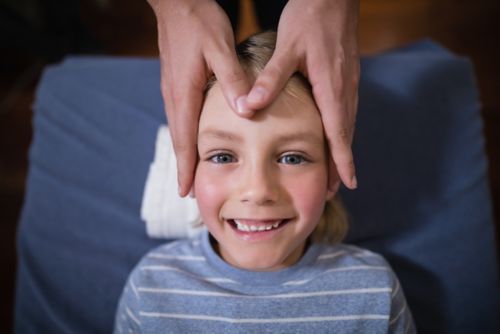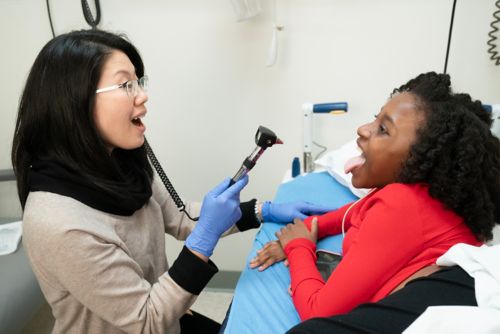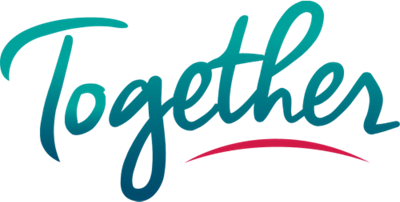How Acupoint Therapy Can Help Children with Serious Illness

Acupoint therapy is a touch therapy that can help relieve symptoms in children with serious illness.
Acupoint therapy is a type of treatment within Traditional Chinese Medicine that goes back thousands of years. A care provider applies gentle touch stimulation to certain points on the body, called acupoints, to promote healing and well-being. Touch stimulation may be applied by pressure from the fingers or hands (acupressure), inserting very thin needles into the skin or muscles (acupuncture), or the use of suction cups.
For children with cancer and other serious illnesses, acupoint can help the body to work better. Some cells may be affected by cancer, but there are still healthy cells that can be tapped into to help make the body work as well as possible.
Amy Ly, MD, provides acupoint therapy to children at St. Jude Children’s Research Hospital. Her background gives her a deep perspective on the human nervous system. She comes from generations who have practiced Traditional Chinese Medicine and acupoint therapy, and she also has her medical degree and practices as an adult neurologist.
Ly’s years of experience with Traditional Chinese Medicine and her medical training in neurology give her a holistic perspective on both Eastern and Western medicine.

Traditional Chinese Medicine names over 400 pressure points on the body that can promote well-being.
How acupoint therapy works
Ly says that certain spots on our body can be stimulated to help with controlling pain, aiding digestion, regulating mood, and enhancing other natural body responses.
“Acupoint therapy releases proteins, hormones, and brain chemicals that control body functions,” she says. “It has a wide range of effects on blood pressure, body temperature, and sleep. It can also boost the immune system.”
In Traditional Chinese Medicine, the body has over 400 pressure points, each connected to a different system. Every point has a name, a history, and a function. Many points are grouped along pathways called meridians, which connect related areas on the body. For example, the neck region is related to the ankle and wrist area.
What to expect in an acupoint therapy session
In a session for a child, Ly usually asks about any signs and symptoms and how the patient is doing.
“When you have certain symptoms, that’s your body trying to give you feedback to call for a change… to prompt you to do something,” Ly says.
She checks the patient’s eyes, tongue, and feels the pulse on the wrist to better understand what is going on in the body. She can tell a lot about what is going on simply by looking at those 3 things.
Key points about an acupoint therapy visit
- The color and moisture of the tongue can give clues about blood flow and digestion.
- A child’s social and medical background is considered when planning care.
- The visit includes a conversation with the patient and family and a physical exam related to what is going on in their body.
- Information from the conversation and exam is used to create a care plan.
- Treatment for symptoms may include acupressure, heat therapy, massage, dietary changes, or lifestyle changes.
- Families may be shown how to apply acupressure for use at home.
- Tiny ear beads might be used for auricular acupressure to help with symptoms like constipation, nausea, muscle tension, or pain reduction.
- Acupoint and massage are offered together and can enhance each other’s effect.
Connecting the body’s healing points
Treating one part of the body that is not in pain can help relieve symptoms in another area.
Ly likens acupoint therapy to flipping a switch to activate specific functionalities in the body, or ways that the body works.
She explains, “The light is on the ceiling, but the switch is on the wall. When someone is in pain, we can stimulate other areas, because our bodies are related and connected. For example, for a headache, we often work on points in the hands, feet, or sometimes legs.
“If we know which light switch goes with which function, we can influence our body and cause a change or response. Our body came with that built in,” Ly says.

In a typical acupoint therapy appointment, Ly checks the patient’s eyes, tongue, and heart rate.
Benefits of acupoint therapy
Acupoint therapy can help with many symptoms and problems, including:
- Muscle weakness
- Muscle cramps or spasms
- Stiff or tight muscles
- Range of motion
- Balance
- Pain
- Swelling
- Sinus issues
- Menstrual cycles (periods)
- Hiccups
- Dry mouth
- Headaches
- Feeling tired
- Pain in a limb that has been removed
- Not feeling hungry
- Depression
- Low energy
- Chest or nose congestion
- Digestive problems
- Constipation (trouble going to the bathroom)
- Stress
- Anxiety
- Sleep problems
- Nausea and vomiting
- Insomnia
- Wound healing
Who can get acupuncture?
Children getting treatment for cancer or other serious diseases may be eligible for acupuncture therapy. But to keep them safe, they need to meet certain requirements:
- They need to have enough white blood cells (ANC of 500 or higher)
- They also need enough platelets (20,000 or more)
- The child must be at least 2 years old
These checks help make sure acupuncture will not cause problems like bleeding or infection. A trained acupuncture provider who works with children should always do the treatment. The child’s care team will decide if it is safe and right for them.
For children who cannot get acupuncture, Ly advises using acupressure on recommended acupoints throughout the day. She might also recommend cupping. Cupping uses a soft silicone cup to gently pull on the skin, which helps relax tight muscles and stimulate an area.
How caregivers can help
Ly emphasizes the importance of caregivers’ intuition and speaking up about how their child is doing.
“As a caregiver, there is nothing like your intuition to know if something is not quite right with your child,” Ly says. “Care teams depend on your intuition and history to know when to order further tests, imaging, or other treatments. Sharing details about your child like sleep problems, poor appetite, talking less, or being less engaged can help care providers to know what steps to take.”
Other details to pay attention to are:
- How often your child goes to the bathroom
- If they have trouble going (constipation)
- If their stools are loose
- How much they drink
- How many hours of uninterrupted sleep they get
- How hungry or thirsty they feel
- Their body temperature
All of these body functions help to determine how acupoint therapists will work to try to balance and regulate the body.
Risks of acupuncture
Ly likes to tell her patients that “there are not many side effects, but there are a lot of side benefits.”
Acupuncture is usually very safe, but there are a few risks:
- Fainting: If a child is nervous, weak, or tired, they might feel faint. This is called a “vasovagal” response. A good way to prevent this is to treat the patient while they are already lying down and feeling comfortable.
- Needle risks: Improper needling technique can lead to unnecessary pain and possible trauma to the body. Always choose a licensed, experienced practitioner who knows how to treat children with serious illness.
The needles used in acupuncture are very thin. They are clean, one-time-use needles made of stainless steel that are disposed of after use.
Each time an acupuncture procedure is done, the care team does a needle count. The care team documents where each needle was placed on the body and the name of the acupuncture point.
Harness the power of the body
Acupoint therapy can help the body to change. It does this by tapping into the nervous system to activate the body’s natural ability to relieve symptoms.
“Don't underestimate what our body can do,” Ly says. “The question is, how do you tap into that? How do you use your body’s complex, amazing, resilient system to help itself?"
While not a substitute for medical treatment or a cure for serious illness, acupoint therapy can relieve symptoms. Patients who feel a lot of relief often tell Ly, “Why didn’t someone tell me to come to acupoint therapy? Why didn’t I try this sooner?”
“There’s very little to lose, but so much to gain,” she says. “And the ball is in your court. You can always say, ‘I don't want this. I tried it.’ But at least try it because a lot of times you’ll be quite surprised what your body can do on its own.”





